When planning for fencing needs, particularly at the start of the year, it’s essential to avoid the common mistake of making multiple small orders throughout the year. Instead, placing a single bulk order for fence panels at the beginning of the year can result in significant cost savings. Here’s a formula to help you calculate your fencing requirements based on last year’s usage, anticipated growth, and panel maintenance needs.
Fencing Needs Formula:
Total Panels Needed = (Panels Used Last Year + Estimated Sales Increase + Damaged Panels) × (1 + 10% Buffer for Extras)
Let’s break it down step by step:
- Panels Used Last Year:
Start by looking at the number of fence panels you used last year. This will give you a solid baseline for your fencing needs. - Estimated Sales Increase:
Estimate how much you plan to grow or expand your sales this year. If you’re a contractor, business, or rental service, consider how much more fencing you’ll need based on expected demand. A safe estimate is to add a percentage increase—for example, if you expect to increase sales by 20%, multiply the panels used last year by 1.2. - Panels to Retire:
Take into account any fence panels that are too damaged or worn out to be reused. These panels should be factored into your calculation, as they will need to be replaced. - Buffer for Extras:
It’s always a good idea to order a 10% buffer of additional panels and accessories (such as gates, posts, and brackets) in case of unexpected needs or projects. This will help ensure you have enough materials without over-ordering. Simply multiply your total by 1.1 to account for this extra margin.
Example Calculation:
- Panels Used Last Year: 1,000 panels
- Estimated Sales Increase: 15% (add 0.15 to the total)
- Panels to Retire: 50 panels (add this to the total)
- Buffer for Extras: Add 10% more for accessories and unforeseen needs
Total Panels Needed = (1,000 + 150 + 50) × 1.1 = 1,265 panels
So, for the coming year, you would need to order approximately 1,265 fence panels, including your anticipated increase, damaged panels, and an additional 10% buffer.
Extra Tip:
Don’t forget to add an extra 10% of accessories to your order, such as stands, top connectors, and security clamps. In our experience, these smaller items are often lost, damaged from frequent use (especially if you’re renting them out), or simply wear out over time. Ordering a little extra not only ensures you have spares on hand, but also saves you from additional shipping costs if you need to place a separate order later. It’s a smart way to stay ahead and avoid unexpected expenses.
That being said, while this approach may vary depending on the specifics of your business, we believe it’s a great starting point for calculating your fencing needs in a cost-effective way. Planning ahead will help you avoid those unexpected purchases and keep your projects running smoothly. If you’d like to tailor this calculation to your unique needs or just want some advice, we’re here to help. Reach out to us and let’s chat about how we can optimize your fencing strategy and make your planning even easier. We’re excited to help you out!


